Abdoljalil Addeh
Genetic Influences on Brain Aging: Analyzing Sex Differences in the UK Biobank using Structural MRI
May 25, 2025Abstract:Brain aging trajectories differ between males and females, yet the genetic factors underlying these differences remain underexplored. Using structural MRI and genotyping data from 40,940 UK Biobank participants (aged 45-83), we computed Brain Age Gap Estimates (BrainAGE) for total brain, hippocampal, and ventricular volumes. We conducted sex-stratified genome-wide association studies (GWAS) and Post-GWAS analyses to identify genetic variants associated with accelerated brain aging. Distinct gene sets emerged by sex: in females, neurotransmitter transport and mitochondrial stress response genes were implicated; in males, immune and inflammation-related genes dominated. Shared genes, including GMNC and OSTN, were consistently linked to brain volumes across sexes, suggesting core roles in neurostructural maintenance. Tissue expression analyses revealed sex-specific enrichment in pathways tied to neurodegeneration. These findings highlight the importance of sex-stratified approaches in aging research and suggest genetic targets for personalized interventions against age-related cognitive decline.
* 7 pages, 5 figures, conference
Direct Estimation of Pediatric Heart Rate Variability from BOLD-fMRI: A Machine Learning Approach Using Dynamic Connectivity
Feb 10, 2025Abstract:In many pediatric fMRI studies, cardiac signals are often missing or of poor quality. A tool to extract Heart Rate Variation (HRV) waveforms directly from fMRI data, without the need for peripheral recording devices, would be highly beneficial. We developed a machine learning framework to accurately reconstruct HRV for pediatric applications. A hybrid model combining one-dimensional Convolutional Neural Networks (1D-CNN) and Gated Recurrent Units (GRU) analyzed BOLD signals from 628 ROIs, integrating past and future data. The model achieved an 8% improvement in HRV accuracy, as evidenced by enhanced performance metrics. This approach eliminates the need for peripheral photoplethysmography devices, reduces costs, and simplifies procedures in pediatric fMRI. Additionally, it improves the robustness of pediatric fMRI studies, which are more sensitive to physiological and developmental variations than those in adults.
Learning Algorithms Made Simple
Oct 11, 2024Abstract:In this paper, we discuss learning algorithms and their importance in different types of applications which includes training to identify important patterns and features in a straightforward, easy-to-understand manner. We will review the main concepts of artificial intelligence (AI), machine learning (ML), deep learning (DL), and hybrid models. Some important subsets of Machine Learning algorithms such as supervised, unsupervised, and reinforcement learning are also discussed in this paper. These techniques can be used for some important tasks like prediction, classification, and segmentation. Convolutional Neural Networks (CNNs) are used for image and video processing and many more applications. We dive into the architecture of CNNs and how to integrate CNNs with ML algorithms to build hybrid models. This paper explores the vulnerability of learning algorithms to noise, leading to misclassification. We further discuss the integration of learning algorithms with Large Language Models (LLM) to generate coherent responses applicable to many domains such as healthcare, marketing, and finance by learning important patterns from large volumes of data. Furthermore, we discuss the next generation of learning algorithms and how we may have an unified Adaptive and Dynamic Network to perform important tasks. Overall, this article provides brief overview of learning algorithms, exploring their current state, applications and future direction.
Three-Dimensional Amyloid-Beta PET Synthesis from Structural MRI with Conditional Generative Adversarial Networks
May 03, 2024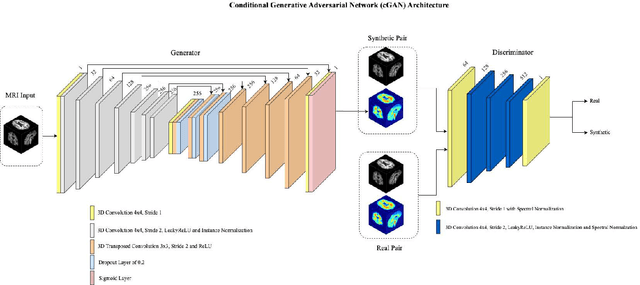
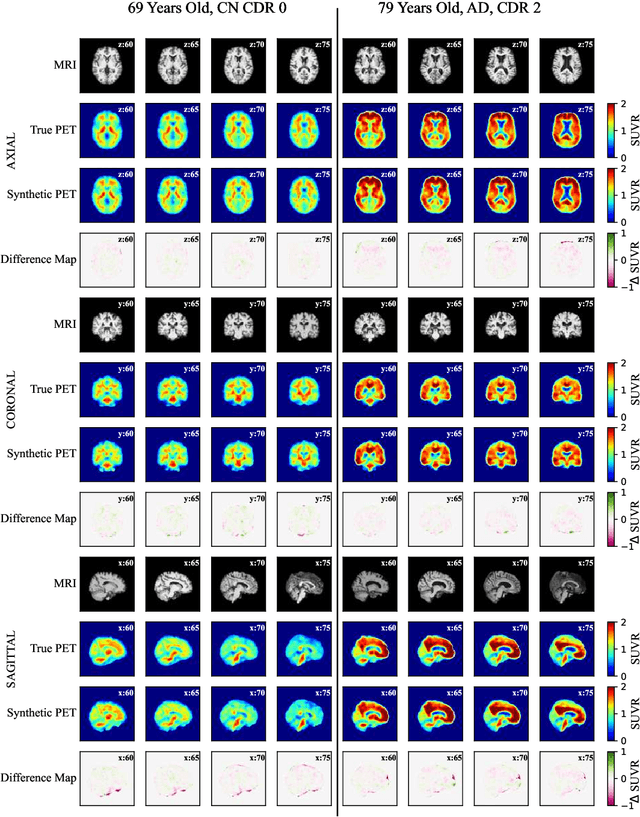
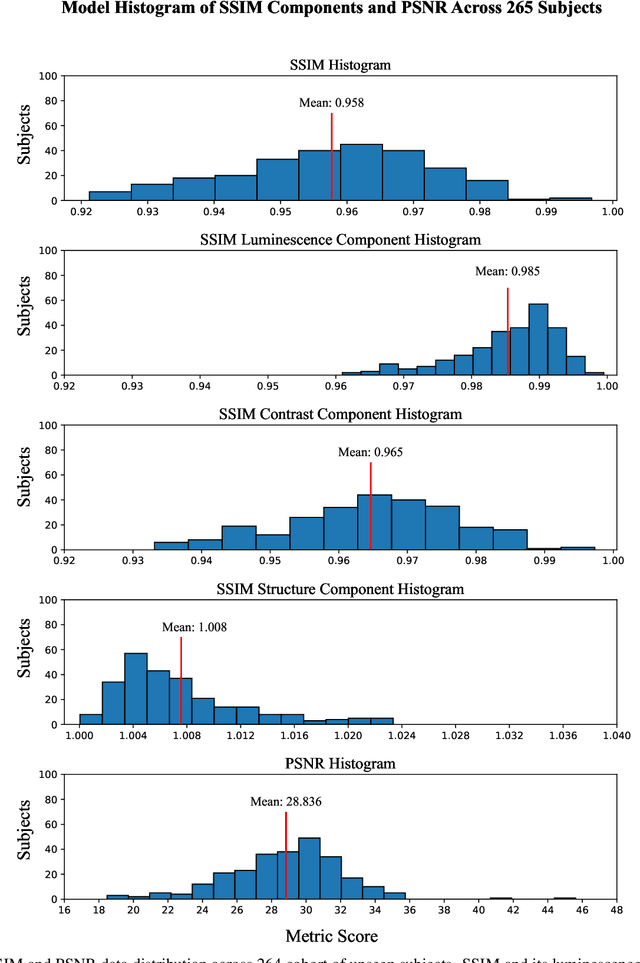

Abstract:Motivation: Alzheimer's Disease hallmarks include amyloid-beta deposits and brain atrophy, detectable via PET and MRI scans, respectively. PET is expensive, invasive and exposes patients to ionizing radiation. MRI is cheaper, non-invasive, and free from ionizing radiation but limited to measuring brain atrophy. Goal: To develop an 3D image translation model that synthesizes amyloid-beta PET images from T1-weighted MRI, exploiting the known relationship between amyloid-beta and brain atrophy. Approach: The model was trained on 616 PET/MRI pairs and validated with 264 pairs. Results: The model synthesized amyloid-beta PET images from T1-weighted MRI with high-degree of similarity showing high SSIM and PSNR metrics (SSIM>0.95&PSNR=28). Impact: Our model proves the feasibility of synthesizing amyloid-beta PET images from structural MRI ones, significantly enhancing accessibility for large-cohort studies and early dementia detection, while also reducing cost, invasiveness, and radiation exposure.
Machine Learning-based Estimation of Respiratory Fluctuations in a Healthy Adult Population using BOLD fMRI and Head Motion Parameters
Apr 30, 2024



Abstract:Motivation: In many fMRI studies, respiratory signals are often missing or of poor quality. Therefore, it could be highly beneficial to have a tool to extract respiratory variation (RV) waveforms directly from fMRI data without the need for peripheral recording devices. Goal(s): Investigate the hypothesis that head motion parameters contain valuable information regarding respiratory patter, which can help machine learning algorithms estimate the RV waveform. Approach: This study proposes a CNN model for reconstruction of RV waveforms using head motion parameters and BOLD signals. Results: This study showed that combining head motion parameters with BOLD signals enhances RV waveform estimation. Impact: It is expected that application of the proposed method will lower the cost of fMRI studies, reduce complexity, and decrease the burden on participants as they will not be required to wear a respiratory bellows.
Amyloid-Beta Axial Plane PET Synthesis from Structural MRI: An Image Translation Approach for Screening Alzheimer's Disease
Sep 01, 2023
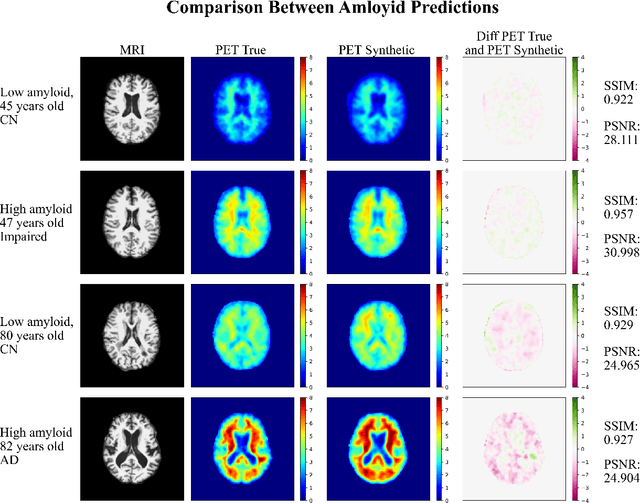

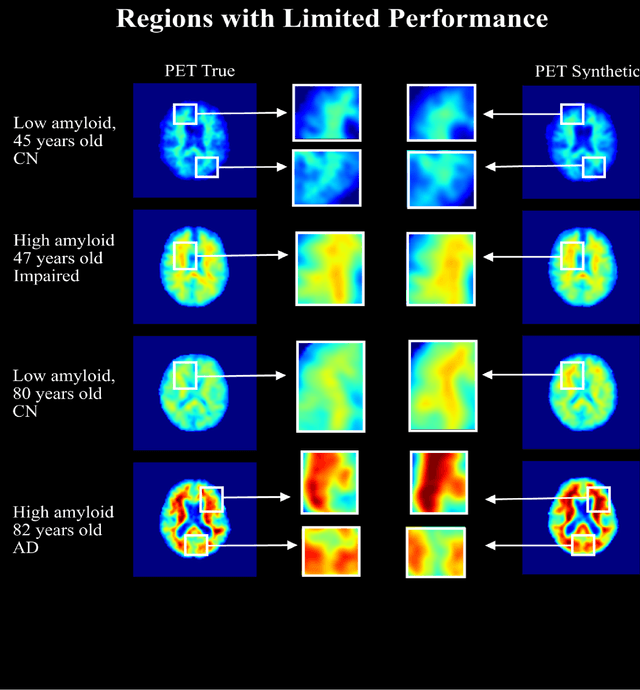
Abstract:In this work, an image translation model is implemented to produce synthetic amyloid-beta PET images from structural MRI that are quantitatively accurate. Image pairs of amyloid-beta PET and structural MRI were used to train the model. We found that the synthetic PET images could be produced with a high degree of similarity to truth in terms of shape, contrast and overall high SSIM and PSNR. This work demonstrates that performing structural to quantitative image translation is feasible to enable the access amyloid-beta information from only MRI.
Denoising Simulated Low-Field MRI (70mT) using Denoising Autoencoders (DAE) and Cycle-Consistent Generative Adversarial Networks (Cycle-GAN)
Jul 12, 2023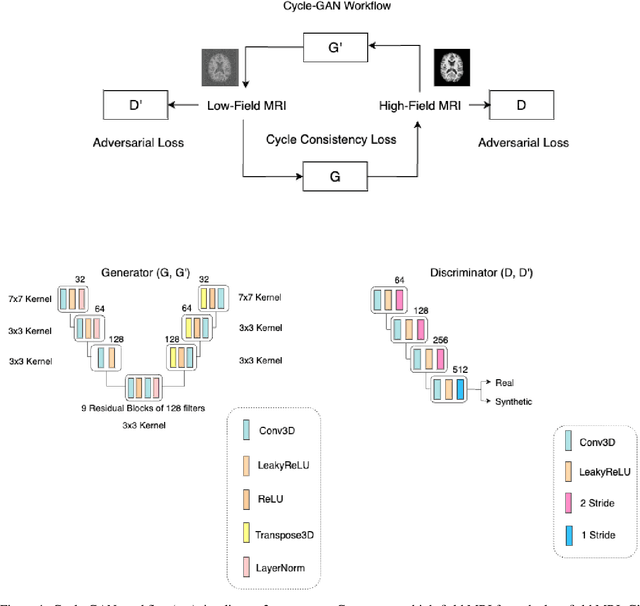
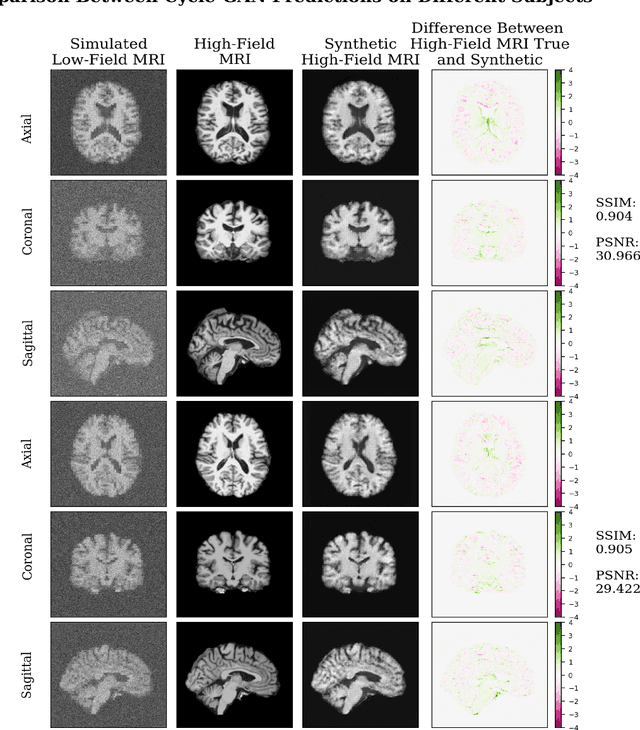
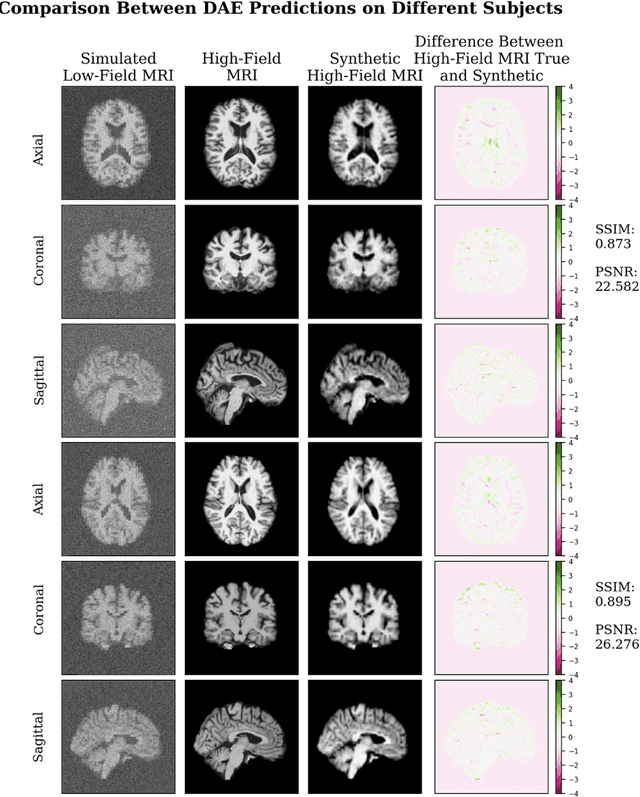
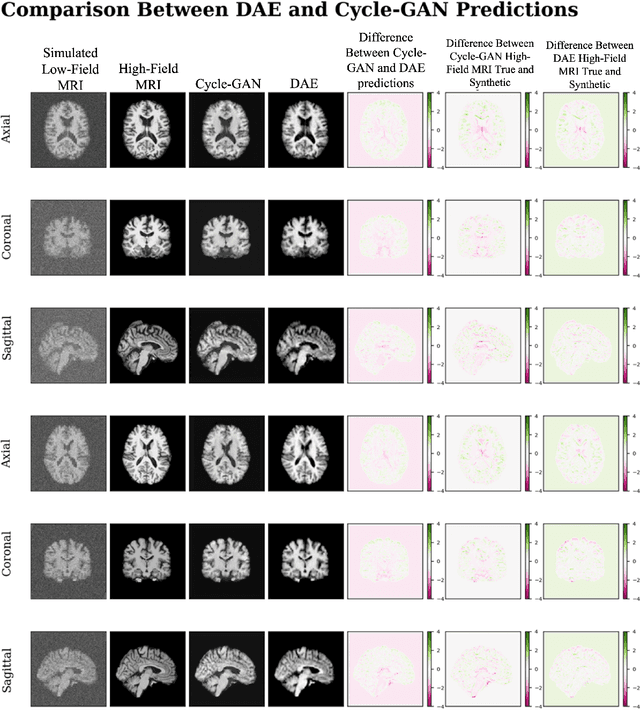
Abstract:In this work, a denoising Cycle-GAN (Cycle Consistent Generative Adversarial Network) is implemented to yield high-field, high resolution, high signal-to-noise ratio (SNR) Magnetic Resonance Imaging (MRI) images from simulated low-field, low resolution, low SNR MRI images. Resampling and additive Rician noise were used to simulate low-field MRI. Images were utilized to train a Denoising Autoencoder (DAE) and a Cycle-GAN, with paired and unpaired cases. Both networks were evaluated using SSIM and PSNR image quality metrics. This work demonstrates the use of a generative deep learning model that can outperform classical DAEs to improve low-field MRI images and does not require image pairs.
Using BOLD-fMRI to Compute the Respiration Volume per Time and Respiration Variation with Convolutional Neural Networks in the Human Connectome Development Cohort
Jul 03, 2023



Abstract:In many fMRI studies, respiratory signals are unavailable or do not have acceptable quality. Consequently, the direct removal of low-frequency respiratory variations from BOLD signals is not possible. This study proposes a one-dimensional CNN model for reconstruction of two respiratory measures, RV and RVT. Results show that a CNN can capture informative features from resting BOLD signals and reconstruct realistic RV and RVT timeseries. It is expected that application of the proposed method will lower the cost of fMRI studies, reduce complexity, and decrease the burden on participants as they will not be required to wear a respiratory bellows.
 Add to Chrome
Add to Chrome Add to Firefox
Add to Firefox Add to Edge
Add to Edge